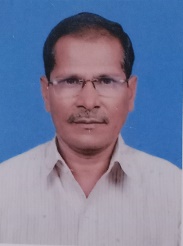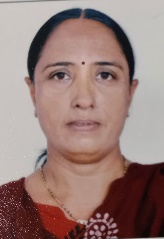Millet Research Station, Jamnagar
Pearl Millet Research Station
Junagadh Agricultural University
Jamnagar-361 006
Brief History of pearl millet improvement in Gujarat:
-
Initially the work on pearl millet was stared as early as 1932 at Nadiad in Gujarat by erstwhile Bombay province with the exploitation of local material. In the ex. Saurashtra province during 1st Five year plan the ICAR scheme of (50% ICAR+50% state) was started at Palitana farm in the year 1949-50 and it was shifted to Jamnagar then farm Aliabada with administration office at Jamnagar and again farm shifted at Jamnagar.
-
The earlier work resulted in developing the open pollinated varieties in the year 1939 viz., N. 207 which yielded 20% more yield than local, N-28-15-2, L-11, Babapuri, etc. These types were quite distinct stable types, which were adopted by farmers. They had good grain qualities but were poor yielders and tall in height.
-
With the formation of the Saurashtra state in 1950, the improvement of Pearl millet was taken up at Junagadh, Amreli and Jamnagar and in the second five year plan (1956-57 to 1960-61), the research work on pearl millet was intensified at Talod and Deesa.
-
The real work on pearl millet research in newly formed Gujarat state got momentum in third five year plan (1961-62 to 1965-66) with the establishment of Millet Specialist post in the year 1962 with main station at Jamnagar and four sub stations viz. Kothara(Kutch) presently with SDAU, Vijapur (Mehsana)presently with SDAU, Anand presently with AAU and Talaja(Bhavnagar) presently with JAU.
-
In 1963, we got assistance from The Rockefeller Foundation by way of germplasm male sterile American Bajri. This was the real beginning of the improvement of pearl millet work not only in Gujarat state but India too and this is a turning point in the history of pearl millet improvement in India.
-
All India Coordinated project on Millets Research was started in 1969-70.
-
The heterosis breeding started from the year 1963 and as a result our first hybrid HB-2 released in 1966. The HB-2 was quickly replaced by superior new hybrid HB-3 in 1968. This HB-3 had a superior grain quality, very high yielding, early maturing, good tillering and resistance to downey mildew disease
-
HB-3 became very popular in pearl millet growing area of whole India. This hybrid has covered 66 % area of pearl millet in the year 1973 in Gujarat state.
-
In the second phase (1980 to 2000) and third phase (2001 to till date) number of hybrids for catering the need of farmers of India as well as Gujarat state. In third phase station has also release the biofortified hybrids having the high Fe and Zn contents in its grain.
-
Since start of Jamnagar station, total 23 hybrids suited under varied agro climatic situation has been released.
Incumbency chart of the Research Scientist (Pearl Millet) office
|
Sr.
|
Name of Scientist
|
Period
|
|
1
|
Dr. J.V. Majmudar
|
19-07-1962 to 30-06-1968
|
|
2
|
Shri R.R. Vohra
|
01-07-1968 to 26-01-1970
|
|
3
|
Dr. J.V. Majmudar
|
27-01-1970 to 12-06-1971
|
|
4
|
Dr. M.T. Parmar
|
13-06-1971 to 02-12-1971
|
|
5
|
Shri K.V. Ramasubrahmanyam
|
03-12-1971 to 26-08-1974
|
|
6
|
Dr. C.K. Jagani
|
27-08-1974 to 26-09-1974
|
|
7
|
Dr. H.R. Dave
|
27-09-1974 to 31-01-1995
|
|
8
|
Dr. K.V. Pethani
|
01-02-1995 to 13-07-1999
|
|
9
|
Shri K.V. Buhecha
|
14-07-1999 to 09-09-2001
|
|
10
|
Dr. C.J. Dangaria
|
10-09-2001 to 31-05-2010
|
|
11
|
Dr. K.L. Raghvani
|
01-06-2010 to 31-08-2012
|
|
12
|
Dr. P.R. Padhar
|
01-09-2012 to 31-08-2015
|
|
13
|
Dr. M.D. Khanpara
|
01-09-2015 to 30-09-2018
|
|
14
|
Dr. D.L. Kadvani
|
01-10-2018 to 31-05-2020
|
|
15
|
Dr. K.D. Mungra
|
01-06-2020 to Continue
|
Introduction:
Pearl millet in Gujarat is cultivated during three different season viz. kharif, semi-rabi(late kharif) and summer. The Jamnagar centre is the Main Pearl Millet Research Station in Gujarat state and scientists of various disciplines viz., Plant breeding, plant pathology, plant physiology, agronomy, seed technology and agricultural entomology working collectively together on pearl millet for development of cultivars, natural resource management (NRM) technologies, plant protection technologies and seed production technology.
Since the establishment of Pearl Millet Research Station at Jamnagar, a great headway had been made and as a result of research efforts in pearl millet crop, the average normal yield of farmers’ fields of 310 kg/ha (1961) has gone high up to 2281 kg/ha (2020-21). Further, farmers of Gujarat also started the cultivating the pearl millet during summer on large scale and in semi rabi (post rainy) season in small scale. This has become largely possible because of development of pearl millet hybrids, its production as well as protection technologies and its adoption by farmers of Gujarat. The Jamnagar Station has been proved to be the most suitable selection for conducting the research in pearl millet crop, as under Jamnagar conditions, it is possible to raise the pearl millet in three different season in a year viz., Kharif, semi-rabi and summer. Thus helping in generation advancement breeder seed production under time isolation and testing the material in short time.
Mandate:
1. Development of high yielding with better nutrients content, biotic and abiotic stress resistance, agronomic technology responsive pearl millet hybrid utilizing available genetic resources in pearl millet based cropping systems through multidisciplinary work under the ICAR-AICRP on Pearl Millet as well as state funded projects.
2. Seed technological research aspect work under the STR components of AICRP on seed (Crops) project.
3. Evaluation and testing of cultivars of oil seed crops under the state oil seed project.
4. Production of nucleus/breeder seed as per indent.
5. Diffusion of developed technology
Objectives:
1. Collection and maintenance and utilization of pearl millet germplasm.
2. Development and use of diversified downy mildew resistant restorer lines, cytosterile lines with diverse CMS sources and maintainers of pearl millet.
3. Development and evaluation of early/medium/late duration, disease and pest resistant hybrids of pearl millet suitable for different agro-ecological zones of the country and Gujarat under different growing seasons.
4. To generate basic information on seed certification standards including seed health
5. Research and development of cost effective eco-friendly integrated production technology on natural resource management, plant protection, stress management and organic farming for remunerative pearl millet cultivation.
6. Screening and identification of pearl millet breeding materials resistance against major biotic and abiotic stresses for utilization in development of hybrids.
7. Identification and assessment of environmental stress resistance/tolerance of pearl millet hybrids/parents through physiological research
8. Evaluation of varieties/hybrids of oilseeds crops
9. Scaling up activity of new released technology of pearl millet production
10. Production and distribution of nucleus/breeder seed as per indent of pearl millet and other JAU mandated crops.
Major Thrust areas:
1. To conduct location specific research on priority areas of arid, semi-arid zone vis-a-vis collection and utilization of genetic resources for development of high yielding hybrids with wide adaptability.
2. Genetic diversification of restorers and male sterile lines to overcome narrow genetic base of cultivated hybrids through development of downy mildew resistant CMS lines in A5 and A4 sources.
3. To identify early/medium/late maturity type high yielding diseases and pest resistant hybrids along with nutritional quality for different agro-ecological situations utilizing conventional and unconventional tools of crop improvement
4. Studies on seed technology aspects viz., seed production and certification, seed physiology, storage and testing, seed health and seed entomology.
5. Variety characterization, lab as well as field study for newly released and promising hybrids of pearl millet.
6. To accomplish the agronomic practices viz, fertilizer management, weed management, irrigation management, moisture conservation techniques, agronomic bio fortification, cropping system and cropping sequences of the rainfed/irrigated (summer/pre-rabi) pearl millet to improve and increase grain and fodder yield and to develop package of practices of pearl millet under organic and natural farming condition
7. Screening of pearl millet hybrids, parents and other breeding materials for their resistance to various diseases viz., downy mildew, ergot, smut, rust and blast.
8. Developmentof integrated disease management (IDM) module against major diseases of pearl millet
9. Survey and monitoring of pearl millet diseases situation on farmer’s field and monitoring pearl millet diseases, occurrence in relation to various metrological factors.
10. Screening and identification of breeding materials against major insects of pearl millet
11. Development of IPM module for the control of major insect pests in pearl millet.
12. Survey and monitoring of insect-pests occurrence on farmers field
13. Evaluation of MS lines, inbreds and hybrids for drought resistance/tolerance vis-à-vis study of various physiological parameters in relation to drought resistance/tolerance.
14. Production of parental lines breeder seed as per state and national indents
15. Todisseminate the newly developed pearl millet technology to farmer’s field through FLDs and capacity building of farmers.
Faculty:
|
Sr.
|
Name
|
Designation
|
Discipline
|
Qualification
|
Photo
|
|
1
|
Dr. K.D. Mungra
|
I/c Research Scientist (Pearl Millet)
|
Genetics & Plant Breeding
|
Ph.D.
|
 |
|
2
|
Dr. K.K. Dhedhi
|
Assoc. Res. Scientist
|
Genetics & Plant Breeding
|
Ph.D.
|
 |
|
3
|
Dr. G.M. Parmar
|
Assoc. Res. Scientist
|
Agril. Entomology
|
Ph.D.
|
 |
|
4
|
Dr. H.M. Bhuva
|
Assoc. Res. Scientist
|
Agronomy
|
Ph.D.
|
 |
|
5
|
Dr. M.M.Talapada
|
Assoc. Res. Scientist
|
Genetics & Plant Breeding
|
Ph.D.
|
 |
|
6
|
Prof. Asha C. Detroja
|
Asstt. Res. Scientist
|
Agronomy
|
M.Sc.(Agri)
|
 |
|
7
|
Prof. J.S. Sorathiya
|
Asstt. Res. Scientist
|
Genetics & Plant Breeding
|
M.Sc.(Agri)
|
 |
|
8
|
Prof. R.P. Juneja
|
Asstt. Res. Scientist
|
Agril. Entomology
|
M.Sc.(Agri)
|
 |
|
9
|
Dr. S.K. Parmar
|
Asstt. Res. Scientist
|
Genetics & Plant Breeding
|
Ph.D.
|
 |
|
10
|
Dr. R.J.Chaudhari
|
Asstt. Res. Scientist
|
Plant Pathology
|
Ph.D.
|
 |
|
11
|
Shri C.R. Sable
|
Agriculture Officer
|
Agriculture
|
Diploma Agriculture
|
 |
|
12
|
Dr. S.N. Galani
|
Agriculture Officer
|
Genetics & Plant Breeding
|
Ph.D.
|
 |
|
13
|
Shri P.R. Patel
|
Agriculture Officer
|
Agronomy
|
M.Sc.(Agri)
|
 |
|
14
|
Sh. N.N. Chaudhari
|
Agriculture Officer
|
Agronomy
|
M.Sc.(Agri)
|
 |
|
15
|
Kum. Vidhi D. Hirpara
|
Agriculture Officer
|
Agriculture
|
B.Sc.(Agri)
|
 |
|
16
|
Shri D.K.Patel
|
Agriculture Officer
|
Agriculture
|
Diploma Agriculture |
 |
Infrastructure:
|
Total area of farm
|
:
|
37 ha
|
|
Farm area under cultivation
|
:
|
24 ha
|
|
Area under Agricultural crops
|
:
|
24 ha
|
|
Area under Farm Forestry
|
:
|
0.8 ha
|
|
Area under Farm structure/buildings
|
:
|
8.2 ha
|
|
Irrigated area
|
:
|
18 ha
|
|
Source of irrigation
|
:
|
Tube well (No.): One
Dug well (No.) : Four
|
Scheme Continue at JAU, Jamnagar:
|
Sr.
No.
|
Name of the scheme
|
Budget Head
|
Type of Scheme (Plan/
Non-Plan)
|
Funding
Agency
|
|
1
|
Scheme for Strengthening Research in Millet
|
12002
|
Plan
|
State Govt.
|
|
2
|
Scheme of Agricultural Meteorology
|
12907
|
Plan
|
State Govt.
|
|
3
|
Project for Research in Millet
|
5002
|
Non-Plan
|
State Govt.
|
|
4
|
National Agricultural Research Project (Pearl Millet)
|
7082-B
|
Non-Plan
|
State Govt.
|
|
5
|
Project for Research in Oilseeds
|
5008
|
Non-Plan
|
State Govt.
|
|
6
|
All India Coordinated Research Project on Pearl Millet
|
2002
|
ICAR
|
ICAR(75%)
|
|
7
|
CRP on Biofortification
|
2002-07
|
ICAR
|
ICAR(100%)
|
|
8
|
FLD on coarse cereals under NFSM
|
2704-42
|
ICAR
|
ICAR(100%)
|
|
9
|
JAU revolving Fund
|
9510-J-62
|
University
|
Revolving fund
|
|
10
|
ICAR-Research and development efforts on hybrids in selected crops : Pearl Millet
|
2076-5
|
ICAR Revolving
|
Revolving fund
|
|
11
|
Testing Charges for Millet
|
18005-09
|
Other Agency
|
Other Agency
|
Project/scheme completed
|
Sr.
No.
|
Name of the project/scheme completed
|
Budget Head
|
Type of Scheme (Plan/
Non-Plan)
|
Funding
Agency
|
Year of start
|
Year of completion
|
|
1
|
Harvest Plus Project
|
18005-10
|
Other agency
|
ICRISAT (100%)
|
2009-10
|
2021-22
|
|
2
|
Harnessing Opportunity for Productivity Enhancement (HOPE) of sorghum and millets in Sub-Saharan Africa and South Asia
|
18057
|
Other agency
|
ICRISAT (100%)
|
2010
|
2014 but extended upto June 2015
|
|
3
|
Application of biotechnology for pearl millet improvement
|
18247-11
|
RKVY
|
Central sector (100%)
|
2009-10
|
2011-12
|
|
4
|
Management of cotton milibug Ferrisia virgata (cocrel)
|
18247-10
|
RKVY
|
Central sector (100%)
|
2009-10
|
2011-12
|
|
5
|
Quality seed production of groundnut, wheat and pearl millet)
|
18247-03
|
RKVY
|
Central sector (100%)
|
2009-10
|
2011-12
|
|
6
|
Screening of high biomass population, breeding lines and hybrids in Gujarat
|
18246-99
|
Other agency
|
ICRISAT (100%)
|
2013-14
|
2014-15
|
|
7
|
Heterotic pool formation in pearl millet
|
18246-98
|
Other agency
|
ICRISAT (100%)
|
2015-16
|
2016-17
|
Hybrids released during last twenty year:
|
Sr. No.
|
Hybrids/
Variety
|
Pedigree
|
Year of release
|
Condition
of recomme-ndation
|
Area of adoption
|
Maturity duration and salient features
|
|
1
|
GHB-526
|
ICMA 95222
x
J-2372
|
2002
|
Summer
|
Across the country
|
Late type 75-80 days, medium tall, good tillering, narrow leaves with greenish white mid rib, compact conical ear heads with obovate gray brown grains.
|
|
2002
|
Pre-rabi
|
Gujarat
State
|
||||
|
2
|
GHB-558
Late type
|
ICMA 94555
x
J-2290
|
2002
|
Kharif
|
Across the country
|
75-80 days, medium tall, good tillering, broad leaves, long thick compact conical ear heads with obovate dark gray bold grains.
|
|
|
2003
|
Summer
|
Across the country
|
|||
|
3
|
GHB-577
Medium duration
|
JMSA-101
x
J-2405
|
2003
|
Kharif
|
For Zone ‘A’ of the country
|
70-75 days, tall, good tillering, medium thick stem with basal pigmentation, semi compact cylindrical ear heads and globular grains.
|
|
4
|
GHB-538 Early type
|
ICMA
95444
x
J-2340
|
2004
|
Kharif
|
For Zone 'A1' of the country
|
65-70 days, medium tall, good tillering, drought resistant, compact cylindrical ear heads, globular light brownish gray colour grains.
|
|
2006
|
Summer &
Pre-Rabi
|
Gujarat State
|
||||
|
5
|
GHB-719 Early type
|
ICMA
95222
x
J-2454
|
2006
|
Kharif
|
For Zone 'A1' of the country
|
70-74 days, medium tall, good tillering, drought resistant, compact cylindrical with bristle ear heads, globular light brownish gray colour grains.
|
|
6
|
GHB-732
Late type
|
ICMA
96222
x
J-2340
|
2007
|
Kharif
|
For Zone ‘A’ of the country
|
80-85 days, medium tall, good tillering, broad leaves long thick compact ear heads, bold globular grains with attractive color.
|
|
2011
|
Summer
|
Gujarat State
|
||||
|
7
|
GHB-744
|
ICMA
98444
x
J-2340
|
2007
|
Kharif
|
For Zone ‘A’ of the country
|
Medium duration 76-80 days, tall, good tillering, medium thick stem with basal pigmentation, compact and medium long ear heads, bold globular grains with attractive color.
|
|
8
|
GHB-757
|
ICMA
92777
x
J-2467
|
2007
|
Kharif
|
For Zone 'A1' of the country
|
Early type 70-74 days, medium tall, good tillering, drought resistant, compact, medium long ear heads, medium grain size with attractive color.
|
|
9
|
GHB-905
|
ICMA
04999
x
J-2454
|
2012
|
Kharif
|
For Zone 'A' of the country
|
Medium duration 75-80 days, medium tall, good tillering, drought resistant, compact, medium long with bristled ear head, medium grain size with attractive color.
|
|
10
|
GHB 1129 (Jam Shakti)
Biofortified
|
ICMA 99222
x
J-2565
|
2019
|
kharif and Summer
|
For Gujarat state
|
Medium maturing, medium size globular, grey brown colourgrain, with compact cylindrical head and resistant to downy mildew and blast diseases.
Fe >70 ppm and
Zn> 40 ppm
|
|
12
|
GHB 1225 (Moti Shakti)
Biofortified
|
ICMA 98222
x
J-2591
|
2019
|
Kharif
|
For Gujarat state
|
Late maturing, compact thick panicle, deep gray hexagonal shape medium grain and resistant to downy mildew and blast diseases. Fe >70 ppm and Zn> 40 ppm
|
|
13
|
GHB 1231 (Sawaj Shakti)
Biofortified
|
ICMA 11222
x
J-2597
|
2020
|
kharif
|
For Gujarat state
|
Late maturing, conical shape thick panicle, yellow colour globular shape medium grain and resistant to downy mildew and blast diseases.Fe >70 ppm and Zn> 40 ppm
|
|
2021
|
Summer and Semi rabi
|
For Gujarat state
|
||||
|
14
|
GHB 538 (EDV:DM) (Maru Sona)
|
ICMA
95444
x
J-2340 improved
|
2021
|
kharif
|
For Gujarat state
|
Marker assisted selection improved version of earlier released hybrid GHB-538. Resistance against DM and blast disease, early 65-70 days maturity, medium tall, good tillering, compact long cylindrical ear heads, globular grey brown grains.
|
Awards / appreciation received by station and faculty:
-
Dr. H.R. Dave and Co-workers were awarded “Sardar Patel award” in 1997 for the development and release of first summer pearl millet hybrid GHB-183.
-
Chaudhary Devilal outstanding All-India Coordinated Research Project (AICRP) Award for the year 2003 was awarded to Pearl Millet Research Station, JAU, Jamnagar for significant contribution in pearl millet research
-
The Society for Millet Research and AICPMIP on 2nd May, 2005 honoured the Jamnagar centre as “Best AICRP Centre” for outstanding contribution in pearl millet research.
-
The research paper presented by Dr. C.J. Dangaria and co-workers at National Symposium on “alternative use of millets” in India held at Bikaner on 30th April, 2005 was judged as a best paper.
-
Dr. A.K. Joshi and Co-workers received the best poster paper award during national seminar on “stress management in arid and semi-arid ecosystems for productivity enhancement in Agriculture on sustainable basis” held at Sardar Krishinagar held during 11-13 April, 2005.
-
Dr. C.J. Dangaria, Research Scientist (Pearl Millet) was awarded “Best Scientist Award” by Indian Society of Millet Research on 10th April, 2006 for significant contribution in pearl millet improvement by the Jamnagar centre.
-
AICPMIP, Jodhpur appreciated JAU, Jamnagar as “Best AICRP Centre” for taking new research initiatives to promote and adoption of pearl millet hybrids on 12th March 2011.
-
-
The Gujarat Association for Agricultural Sciences (GASS), Ahmedabad appreciated the dedicated work of Dr C J Dangaria, the Ex. Research Scientist (Pearl Millet), JAU, Jamnagar and co-workersfor the “Release of Series of Pearl Millet Hybrids for increasing Cereal Production of Gujarat” and decided to confer upon them“Sadvichar Parivar Award-2013” on 09-10-2014.
-
International Crops Research Institute for the Semi-Arid Tropics (ICRISAT), Hyderabad honors JAU, Jamnagar (one of the HOPE Project partners in South Asia) with the “Outstanding Partnership Award” in recognition of their outstanding contribution in enhancing livelihoods of small holder dryland cereal (post rainy season sorghum and drought tolerant pearl millet) farmers on 12-12-2014.
-
The Gujarat Association for Agricultural Sciences (GASS), Ahmedabad honoured Dr. D. L. Kadvani, Associate Research Scientist, Plant Pathology with “GAAS-Young Scientist Award-2016” for the commendable Best Thesis work for his Ph. D. degree from J.A.U., Junagadh.
-
Dr. H. M. Bhuva, Assoc Res Sci, JAU, Jamnagar presented the paper entitled “Impact of organic fertilizers on growth, yield and quality of pearl millet (Pennisetum glaucum L.) Under rainfed conditions of Gujarat” and Mrs. Asha C. Detroja presented the paper presented the paper entitled “Possibilities of Organic Farming in Pearl Millet (Pennisetum glaucum L.) – Gram (Cicer arietinum L.) cropping sequence under Saurashtra region of Gujarat” in National Conference on “Technological changes and innovations in agriculture for enhancing farmers’ income” held at JAU, Junagadh, Gujarat during 28-31 May, 2017 organized by ASM Foundation, New Delhi an ISO 9001:2008 certified organization and both papers judged as “Best oral presentation”.
-
ICRISAT honors Dr. K. D. Mungra one of the co-authour of paper entitle ‘Phenotypic data from inbred parents can improve genomic prediction in pearl millet hybrids’) for the “Outstanding Scientific Article Research Program-Asia” on 14-12-2018.
-
ICAR-AICRP on Pearl Millet, Jodhpur and Society for Millets Research, Hyderabad honour Dr. K. D. Mungra, Associate Research Scientist (Plant Breeding genetics), JAU, Jamnagar for “Best Scientist Award (2017-18)” in the AGM of pearl millet workers held at Jodhpur on 24-03-2018.
-
Dr C.J. Dangariya ex Research Scientist(Pearl Millet), JAU, Jamnagar and his co-workers honoured on 25-08-2019 by The Indian Society of Genetics and Plant Breeding, New Delhi by certificate of recognition for development of landmark Pearl Millet hybrid GHB-538 and contributing towards food and nutritional security of the country.
-
The Gujarat Association for Agricultural Sciences (GASS), Ahmedabad on 03.10.2020 appreciate the dedicated work of Dr. K. D Mungra, Research Scientist (Pearl Millet), JAU, Jamnagar and his team members for the “Development of biofortified pearl millet hybrids to fight against iron and zinc deficiency in Gujarat” and decided to confer upon them “Prof. J.P. Trivedi Award (2018)” on 03-10-2020.
-
ICAR-AICRP on Pearl Millet, Jodhpur presented certificate of appreciation to ICAR-AICRP on Pearl Millet, JAU, Jamnagar for “Best performing ICAR-AICRP on Pearl Millet centre (2020-21)” in online event of AICRP-PM workers group meeting on 23-03-2021.
-
Dr. Sanjay K. Parmar, Assistant Research Scientist, JAU, Jamnagar is bestowed with “Springer Young Scientist Award” for oral presentation on “Pearl millet hybrid GHB 1129: Gujarat's first effort to combat malnutrition through crop biofortification” in national symposium on “Emerging innovations in plant molecules for achieving food and nutritional security” organized by NAU, Navsari and Division of Biochemistry, ICAR-IARI, New Delhi in association with Society for Plant Biochemistry and Biotechnology, IARI, New Delhi which was held at NAU during September 22-23, 2022.
Research Activities:
Plant Breeding:
- Collection, conservation and evaluation of germplasm during summer breeding programme utilizing various breeding approaches
-
Development and evaluation of disease and pest resistant genetically diverse pollinators-inbreds, CMS lines and hybrids of various maturity groups.
-
Testing of combining ability of male sterile and inbred lines for developing new pearl millet hybrids
-
Development of dual purpose hybrids, varieties, parental lines and novel genetic stocks with resistance to downy mildew, blast, high grain iron and Zn content along with consumer acceptability, conduct and monitor multi-location testing of coordinated trials of pearl millet.
-
Development of high yielding dual purpose disease resistant hybrid suitable and potential under adverse and various climatic conditions like lower rain fall drought resistant for irregular early withdrawn monsoon
-
Identification of suitable hybrids for cultivation under adverse climatic conditions.
-
Development of input responsive downy mildew resistant short or medium duration high yielding hybrids for summer and irrigated Kharif conditions.
-
Evaluation and testing of various newly development varieties / hybrids various oil seeds crops and other JAU mandated crops.
-
Capacity building of farmers and demonstration of yield potential of pearl millet hybrids, and also to demonstrate the benefit of different productiontechnology on farmer’s field.
-
Breeder seed production of pearl millet hybrid parental lines and other JAU mandated crops as per indent.
Seed Technology Research
-
Development of locations specific seed production technology including techniques for seed quality maintenance and improvement
-
Research on seed pest and seed storage of different crops and monitoring of resistance in storage pest infesting in godown are in progress.
-
To disseminate information and impart training on seed production, processing, storage and packaging, quality control and seed health.
-
Research on appropriate seed production technology of newly developed hybrids.
-
Identification of stable diagnostic characters for new pearl millet hybrids.
-
Determination of planting ratio for newly released pearl millet hybrid.
Natural Resource Management:
-
To develop efficient production technologies of pearl millet based cropping system for various agro climatic zones.
-
Develop efficient production strategy involving response to low inputs, cropping systems, unconventional areas (summer season) and contingency planning
-
To workout fertilizer requirement for new and advanced hybrids and population and agronomic bio fortification of pearl millet hybrids.
-
To develop moisture conservation technology through use of polymers and crop residues mulch.
-
To evaluate and identify cost effective pearl millet based crop sequence
-
To evaluate effect of nano-fertilizer and micronutrient on pearl millet production.
-
Integrated nutrient management integrating various sources of nutrients
-
To study the long term effect of FYM and use of bio fertilizer with chemical fertilizer and without chemical fertilizer.
-
To develop production technology to harvest higher yield under organic condition and natural farming.
Pathology
-
Development of integrated disease management (IDM) strategies against pearl millet blast and downy mildew disease using chemical and bio agents.
-
Field and lab screening of breeding materials and identification of diversified sources of multiple diseases resistances to be useful in breeding.
-
Strengthen research on downy mildew, blast and rust diseases management
-
Screening of breeding materials against disease such as downy mildew, smut, rust, ergot and blast
-
Use of new molecules and latest formulation of fungicides for management of blast disease of pearl millet.
-
Monitoring of pearl millet diseases in different location trial and farmers field for identification of new disease or new races of pathogen.
-
Study on the pathogen diversity of downy mildew and blast in pearl millet.
Entomology:
-
Screening of promising pearl millet entries against major insect -pests along with identification of shoot fly resistant pearl millet lines.
-
Study on incidence of store grain pests infesting pearl millet grains.
-
Determine the economic threshold level of shoot fly, stem borer and other pest in pearl millet.
-
Management of insect pests in pearl millet using IPM modules.
-
Monitoring and survey of potential new invasing pest of pearl millet in Gujarat
Crop Physiology
-
Characterization for drought tolerance to identify parental lines of pearl millet.
-
Identification of physiological traits for drought tolerance in pearl millet.
-
Study on photosynthate partitioning & remobilization in pearl millet.
-
Agro-physiological management of the drought in pearl millet.
Transfer of Technologies / Extension Activities:
Apart from the regular training programme on kharif and summer pearl millet crop production, the trainings are also organized for various stakeholders’ viz., farmers and field staff SSC, SSCA and STL with special reference to ODV and other seed technological aspects.
Recently this centre has released biofortified pearl millet hybrids viz., GHB 1129, GHB 1225 and GHB 1231. Due its high yielding potentiality good fodder quality and having nutraceutical values it has become popular among the farmer. For the up-scaling of these recommended technology at farmer’s field we are regularly organising the Front Line Demonstrations (FLDs) during kharif and summer seasons in the state on farmers field and organising the field days on various crops of the district.
The scientists of the centre are actively taking part in Krishi Mahotsav in Gujarat. Under the “Mera Gaon Mera Gaurav” (MGMG) activity this station adopted five villages in different talukas of Jamnagar district and multidisciplinary scientists of this station visits regularly these villages and provides technical guidance to farmers and demonstrate the new technology of farmers field. This centre is providing training and guidance on various agricultural technologies to extension workers and farmers. The scientists of the centre are regularly attending the meetings organized by line departments like KVKs, ATMA, Department of Agriculture, Panchayats, DRDA, GSFC, GNFC etc as a resource person to provide the information on recent production and management technologies of various crops. We are actively participating in agricultural fairs by demonstrating the technology in stall to provide information on recent pearl millet production technologies.
Farmer's / Scientific Recommendations: (Since 2013)
SEED TECHNOLOGY:
1. For scientific community a recommendation was proposed to avoid production losses in bunch groundnut due to pod germination in field under late and excess rainfall conditions during kharif at maturity time. The fresh seed dormancy was studied in nine high yielding bunch groundnut varieties and it was recommended to grow groundnut varieties TG-26, TPG-41 and GG-6 possessing higher degree of seed dormancy (2013).
2. Castor hybrid seed production growing farmers/ seed producers are advised to take castor hybrid seed production programme in Surendranagar district of Gujarat as alternative (new) areas where profitable seed production can be taken up. The new area identified based on favourable climatic condition, higher seed yield and better benefit : cost ratio. (2015).
3. Cluster bean (Guar) growing farmers are recommended to produce higher seed yield per hectare in kharif season, the crop should be sown in first fortnight of July in a spacing of 30 x 10 cm (2015)
4. Emamectin benzoate 5SG @ 2 ppm a.i. (40.0 mg/kg seed) or Spinosad 45 SC @ 2 ppm a.i. (4.4 mg/kg seed) or deltamethrin 2.8 EC @ 1.0 ppm a.i. (0.04 ml/kg seed) treated seeds (at 10% moisture content) stored in moisture impervious bags provide safer storage up to 6-9 months in coastal region. This technology may be adopted (2015).
5. Groundnut pod (<10% Moisture Content) treatment with Emamectin benzoate (5 SG) @ 2 ppm (40 mg diluted in 15 ml water/kg of pod) or Spinosad (45 SC) @ 2ppm (4.4 mg diluted in 15 ml water/kg of pod) can provide effective management of groundnut pod borer during storage up to 6-9 months under ambient condition without affecting seed quality (2018).
6. Acorus calamus TNAU formulation @ 10 ml/kg seed can be used for management of storage insects up to 6 months without affecting seed germination in chickpea seeds (2019).
7. Pre-harvest spraying of emamectin benzoate (5 SG) @ 0.3 ml/L or profenofos (50 EC) @ 1ml/litre at 50% pod maturity and maturity stage can be used for controlling field infestation of pulse bruchid and subsequent adult emergence during storage (2019).
8. In Dhaincha (Sesbania aculeata), foliar application at flowering stage of DAP (20 g/litre water) incorporated with micronutrient mixture containing Zinc as Zinc sulphate (5g/L water) + Boron as Boric acid (3g/L water) + NAA (0.4 g/10 litre water) and pinching at 60 days after sowing leads to enhancement in seed yield of 19% over control. The benefit cost ratio is 1.18. (2020).
9. In Sunhemp (Crotolaria juncea), foliar application at flowering stage of DAP (20 g/litre water) incorporated with micronutrient mixture containing Zinc as Zinc sulphate (5 g/litre water) + Boron as Boric acid (3g/litre water) + NAA (0.4 g/10 litre water) and pinching when main stem attains a height of 90 cm leads to enhancement in seed yield of 86% over control. The benefit cost ratio is 1.97 (2020).
10. In Pillipesara (Vigna trilobata), foliar application at flowering stage of DAP (20 g/litre water) incorporated with micronutrient mixture containing Zinc as Zinc sulphate (5 g/litre water) + Boron as Boric acid (3 g/litre water) + NAA (0.4 g/10 litre water) and pinching at 30 days after sowing leads to enhancement in seed yield of 48% over control. The benefit cost ratio is 1.83 (2020).
11. Green gram seeds can be protected up to two months from pulse beetle infestation during storage (seed purpose) by giving spray in the field either profenophos50 EC 0.05 % (10 ml/10 l of water) or emamectin benzoate 5 SG 0.0015 % (3.0 g/10 litre of water) at 50 and 100 % pod maturity of green gram. (2020)
12. It was recommendedthat after analysis of sample of castor seed, if seed is found to confirm to the prescribed standards, the Certification Agency shall extend the validity of seed of castor for a further period of six months from the date of expiry of previous validity period or date of test, whichever is earlier. It was also suggested that in castor crop second revalidation would be permitted only with special permission of DAC (2021).
13. It was recommendedthat the validity period of groundnut seed shall be six months from the date of test at the time of initial certification. After analysis of sample, if seed is found to confirm to the prescribed standards, the Certification Agency shall extend the validity of seed of groundnut for a further period of three months from the date of expiry of previous validity period or date of test, whichever is earlier. It was also suggested that in case of II revalidation of groundnut seed would not be permitted (2021).
AGRONOMY:
1. The farmers of North Saurashtra Agro-climatic Zone growing hybrid pearl milletduring summerare recommended to sow the crop during second fortnight of February (30 °C Average maximum Temperature) to obtain higher yield and net realization. (2014)
2. The farmers of North Saurashtra agro-climatic zone adopting pearl millet (kharif)– gram (rabi) cropping sequence and interested in organic farming are recommended to apply FYM @ 7.5 t/ha every year to pearl millet only for securing higher net realization and to maintaining soil fertility. (2015)
3. The farmers of North Saurashtra Agro climatic Zone growing hybrid pearl millet during kharif season are recommended to apply 100 kg N/ha and 30 kg phosphorus per hectare for obtaining higher yield and net return.(2015)
4. The farmers of North Saurashtra Agro-climatic Zone growing hybrid pearl millet during kharif season are recommended to apply ZnSO4 and FeSO4 @ 20 kg/ha each, along with recommended dose of fertilizers (80-40-0 kg N-P2O5-K2O/ha) and FYM 5 t/ha for obtaining higher yield and net return as well as for improving grain quality. (2015)
5. The application of atrazine @ 0.4 kg/ha as post emergence at two leaf stage of weed followed by one hand weeding at 35 days after sowing for effective weed management in kharif pearl millet was found as effective as pre-emergence application of atrazine @ 0.5 kg/ha followed by one hand weeding at 35 days after sowing under North Saurashtra Agro-climatic Zone.(2016)
6. The farmers of North Saurashtra Agro-climatic Zone growing hybrid pearl millet during semi rabi season are recommended to sow the pearl millet early maturing variety GHB-538 during first week of October to obtain higher yield and net return. (2017)
7. The farmers of North Saurashtra Agro-climatic Zone adopting organic farming of pearl millet are recommended to apply FYM 10 t/ha and sow pearl millet hybrid GHB-732 or GHB-744 or GHB-538 for achieving higher yield and net realization, maintaining soil fertility and improving quality of produce.(2019)
8. The farmers of North Saurashtra Agro-climatic Zone growing pearl millet in kharif season are recommended to apply hydrogel (350 μm mesh) 2.5 kg/ha as soil application at the time of sowing + pearl millet straw mulch 5.0 t/ha at 30 days after sowing for getting higher yield and net returns and improving moisture availability in soil.(2020)
9. The farmers of Gujarat growing pearl millet in kharif season are recommended to do hand weeding at 3rd and 5th weeks after sowing for effective weed management and achieving higher grain yield and net realization. (2021)
Plant pathology:
1. In pearl millet IDM module consisting seed treatment of chitosan @2.5g/kg seed + Bacillus pumulis INR 7@ 8g/kg found at par with chemical metalxylseed treatment @6g/kg for the management of downy mildew found effective. (AICRP-2015)
2. Application of differentbioagents i.e, Pseudomonas fluorescens, Bacillus subtilis, Trichoderma viride, Trichodermaharzianum@ 8 g/kg seeds and a new chemical Ametoctradin + Dimethomorph @ 0.4 ml/ 500 mlwater managed the downy mildew disease to some extent. (AICRP-2017)
3. Spray applicationof Trifloxystrobin + Tebuconazole-75WG @ 0.05% first at initiation of disease and second spray at15 days after first spray significantly reduced the blast intensityin grain and fodder pearl millet. (AICRP-2017)
4. Minimum downy mildew disease incidence, maximum grain and fodder yield found in treatment PSB(Phosphate Solubilizing bacteria) @ 8 g/kg. (AICRP-2021)
AGRIL. ENTOMOLOGY:
1. Farmers of North Saurashtra Agro-climatic Zone growing kharif pearl millet are advised to treat the seeds with thiamethoxam 35 FS @ 9.0 ml/kg (3.15 g a.i./kg) or imidacloprid 600 FS @ 8.75 ml/kg (5.25 g a.i./kg) seed at the time of sowing followed by spray of either profenophos 40% + cypermethrin 4.0%, 44 EC 0.044% (10 ml/10 litre water; 220 g a.i./ha) or cartap hydrochloride 50 SP 0.05% (10 g/ 10 litre water; 250 g a.i./ha) or thiodicarb 75 WP 0.015% (2 g/10 litre water; 75 g a.i./ha) at 30 days after germination of the crop for the effective management of shoot fly and stem borer. The PHI for these insecticides is 61 days ( 2014)
2. Farmers of North Saurashtra Agro-climatic Zone growing kharif pearl millet are advised to treat the seeds with imidacloprid 600 FS, 8.75 ml/kg seeds, 4.20 g a.i./kg seeds at the time of sowing followed by spray with imidacloprid 17.8 SL, 0.009 % (5.0 ml/10 liter water, 45.39 g a.i./ha) at 35 days after germination of the crop for effective management of shoot fly and stem borer. The PHI for these insecticides is 42 days.(2015)
3. Seed treatment with imidacloprid 600 FS @ 8.75 ml/kg, 4.20 g a.i./kg at the time of sowing followed by spray with spinosad 45 SC, 0.009 % @ 2.0 ml/10 litre at 35 days after germination of the crop found effective for the management of shoot fly and stem borer. The PHI for these insecticides is 42 days. (2015)
4. Farmers of North Saurashtra Agro-climatic Zone growing kharif pearl millet are recommended to spray HNPV @ 450 LE/ha (10 ml/10 lit. water) or Bacillus thuringiensis 5 WP (2 x 108 cfu/g) @ 1.0 kg/ha (20 g/10 lit. water) or Beauveria bassiana 1.15 WP (2 x 106 cfu/g) @ 2.0 kg/ha (40 g/10 lit. water) on appearance of Helicoverpa armigera at ear head stage for effective and economical management of pest. (2018)
5. Spray of DDVP 76 EC @ 0.05 % was found effective and economical for the management of ear head worm, Helicoverpa armigera (Hub) in pearl millet at ear head stage. (2018)
6. The farmers of North Saurashtra Agro-climatic Zone growing organic pearl millet are advised to apply two sprays of Beauveria bassiana 1.15 WP (2 x 106 cfu/g) 50 g/10 litre of water at 30 and 60 days after sowing for the effective and economical management of shoot fly and stem borer, whereas for ear head worm, Helicoverpa armigera one spray of HNPV 250 LE/ha at anthesis stage to be carried out. (2019)
7. The farmers of North Saurashtra Agro-climatic Zone growing kharif pearl millet are advised to apply seed treatment of imidacloprid 600 FS @ 8.75 ml/kg at the time of sowing, removal of shoot fly dead hearts, installation of fish meal traps @ 10/ha (fish meal to be replaced once a week) and spraying of dimethoate 30 EC 0.03 % (10 ml/10 l of water) at 35 days after germination for effective and economical management of shoot fly (2020).
8. Seed treatment of imidacloprid 600 FS @ 8.75 ml/kg seeds + removal of shoot fly dead hearts + fish meal trap @ 10/ha at 7 days after germination (fish meal to be replaced once a week) + spraying of novaluron 10 EC 0.01% (10 ml/10 litre water) at 35 DAG recorded lowest stem borer per cent incidence of pearl millet. (2020)
9. Seed treatment of clothianidin 50 WDG @ 7.5 g/kg seeds followed by spray of fipronil 5 SC 0.01% (20 ml/10 litre water) for shoot fly, while chlorantraniliprole 20 SC 0.006% (3.0 ml/10 litre water) for stem borer at 35 DAG were found effective in pearl millet. (2020)
10. The farmers of Gujarat growing pearl millet in kharif season are recommended to treat seed with imidacloprid 600 FS (8.75 ml/kg) followed by two sprays at 20 and 40 DAG either Beauveria bassiana 1.15 WP (Min. 1 x 108 cfu/g), 0.007 % (60 g/10 l of water) or Panchgavya 3 % (300 ml/10 l of water) for effective and economical management of shoot fly and stem borer. (2022)
11. The 5 % plant damage by stem borer is considered as economic threshold level (ETL) in kharif pearl millet.
PLANT PHYSIOLOGY:
1. The farmers of North Saurashtra Agro-climatic Zone growing kharif pearl millet are advised to go for foliar application of potassium chloride 1.5 % (7.5 kg per ha in 500 litre water) at 30-35 and 50-55 DAS for higher vegetative growth, grain yield and net return.(2017)
2. The farmers of North Saurashtra Agro-climatic Zone growing kharif pearl millet are advised to apply foliar spray of CCC (chloromequet chloride, 99 %) @ 250 ppm (2.5 ml/ 10 litre water) at tillering and post-anthesis stage to get higher grain yield and net return.(2019)
ખેડૂત ઉપયોગી/વૈજ્ઞાનિક માટે ભલામણ(ગુજરાતી ભાષામા):
બીજ તકનીકી સંશોધન:
1. વૈજ્ઞાનિક સમુદાયને ભલામણ કરવામાં આવે છે કે ખરીફ ઋતુમાં ઉભડી મગફળી પાકવાના સમયે મોડા અને વઘુ પડતાં વરસાદને કારણે ખેતરમાં ડોડવામાં દાણા ઉગી જવાથી ઉત્પાદનમાં થતો ઘટાડો ઓછો કરવા માટે, ઉભડી મગફળીની વઘુ ઉત્પાદન આપતી નવ જાતોનાં તાજા બીજમાં સુષુપ્તતા (ડોરમન્સી)ની ચકાસણી ખરીફ ઋતુમાં કરવામાં આવેલ અને તેના પરથી જાણવા મળેલ છે કે મગફળીની ટી.જી.-૨૬, ટીપીજી-૪૧ અને જીજી-૬ જાતો વઘુ પ્રમાણમાં સુષુપ્તતા (ડોરમન્સી) ઘરાવતી હોવાથી તેનું વાવેતર કરવાની ભલામણ કરવામાં આવે છે. (૨૦૧૩)
2. સંકર દિવેલા બીજ ઉત્પાદન કાર્યક્રમ લેતાં ખેડૂતો/ બીજ ઉત્પાદકોને સલાહ આપવામાં આવે છે કે ગુજરાતમાં સંકર દિવેલા બીજ ઉત્પાદનનો કાર્યક્રમ નવા વિસ્તાર તરીકે સુરેન્દ્રનગર જીલ્લામાં લેવામાં આવે તો ફાયદાકારક બીજ ઉત્પાદન લઇ શકાય છે. સારૂ વાતાવરણ, વઘુ બીજ ઉત્પાદન અને હેકટરે વઘુ આવક મળવાથી સુરેન્દ્રનગર જીલ્લાને સંકર દિવેલા બીજ ઉત્પાદનના નવા વિસ્તાર તરીકે ઓળખવામાં આવેલ છે. (૨૦૧૪)
3. ગુવારનું વાવેતર કરતા ખેડૂતોને ભલામણ કરવામાં આવે છે કે ચોમાસામાં ગુવારનું વાવેતર ૩૦ X ૧૦ સે.મી.ના અંતરે, જુલાઇ મહીનાના પ્રથમ પખવાડિયામાં કરવાથી વઘુ ઉત્પાદન મેળવી શકાય છે. (૨૦૧૫)
4. દરીયાઇ કાંઠાવાળા વિસ્તારોમાં બીજને એમામેક્ટીન બેંજોએટ (૪૦ મીલીગ્રામ/ કિ.ગ્રા.બીજ) અથવા સ્પિનોસેડ (૪.૪ મી.લી/કિ.ગ્રા.બીજ) અથવા ડેલ્ટામેથ્રીન ((૦.૦૪ મી.લી/કિ.ગ્રા.બીજ) નો પટ આપી ભેજપ્રૂફ બેગમાં સંગ્રહ કરવાથી જીવાત સામે ૬ થી ૯ મહીના સુધી સુરક્ષીત સંગ્રહ કરી શકાય છે.(૨૦૧૫).
5. મગફળીના ડોડવા (<૧૦ % ભેજ) ને એમેમેક્ટીન બેન્ઝોએટ (૫ એસજી) @ ૨ પીપીએમ (૪૦ મિલિગ્રામ ૧૫ મિલી પાણી/૧ કિલો ડોડવામાં ભેળવવામાં આવે છે) અથવા સ્પિનોસાડ (૪૫ એસસી) @ ૨ પીપીએમ (૪.૪ મિલિગ્રામ ૧૫ મિલી પાણી/૧ કિલો ડોડવામાં ભેળવવામાં આવે છે) સાથે માવજતથી બીજની ગુણવત્તાને અસર કર્યા વિના આસપાસની સ્થિતિમાં ૬-૯ મહિના સુધી સંગ્રહ દરમિયાન મગફળીના પોડ બોરરનું અસરકારક નિયંત્રણ કરી શકાય છે. (૨૦૧૮)
6. ચણાના બીજમાં બીજ અંકુરણને અસર કર્યા વિના ૬ મહિના સુધી સંગ્રહિત જીવાત નિયંત્રણ માટે એકોરસ કેલમસ TNAU ફોર્મ્યુલેશન @ ૧૦ મિલી/કિલો બીજનો ઉપયોગ કરી શકાય છે. (૨૦૧૯)
7. ૫૦% સીંગ પરિપક્વતા અને પરિપક્વતા અવસ્થાએ ઇમામેક્ટીન બેન્ઝોએટ (૫ SG) @ ૦.૩ મિલી/લીટર અથવા પ્રોફેનોફોસ (૫૦EC) @ ૧ મિલી/લીટર નો પૂર્વ-લણણીનો ઉપયોગથી બોટવાના ઉપદ્રવને નિયંત્રિત કરવા અને સંગ્રહ દરમિયાન અનુગામી પુખ્ત ઉદભવને નિયંત્રિત કરવા માટે કરી શકાય છે (૨૦૧૯).
8. ઇક્કડ પાકમાં ડી.એ.પી. (૨૦ગ્રામ/લીટર પાણી) સાથે ઝીંક સલ્ફેટ (૫ગ્રામ/લીટર પાણી) + બોરીક એસીડ (૩ગ્રામ/લીટર પાણી) + નેપ્થેલીક એસેટીક એસીડ(NAA) (૦.૪ગ્રામ/૧૦લીટર પાણી)નું સૂક્ષ્મ તત્વોનું મિક્ષણ ફુલ અવસ્થાએ પર્ણ છંટકાવ કરવાની સાથે સાથે વાવણી પછી ૬૦ દિવસે છોડનો ટોચનો ઉપરનો ભાગ કાપવાથી બીજ ઉત્પાદનમાં વઘારો જોવા મળે છે. જેમાં ૧ રૂપિયાના ખર્ચ સામે ૧.૧૮ રૂપિયાનું વળતર મળે છે. (૨૦૨૦)
9. શણ પાકમાં ડી.એ.પી. (૨૦ગ્રામ/લીટર પાણી) સાથે ઝીંક સલ્ફેટ (૫ગ્રામ/લીટર પાણી) + બોરીક એસીડ (૩ગ્રામ/લીટર પાણી) + નેપ્થેલીક એસેટીક એસીડ(NAA) (૦.૪ગ્રામ/૧૦લીટર પાણી)નું સૂક્ષ્મ તત્વોનું મિક્ષણ ફુલ અવસ્થાએ પર્ણ છંટકાવ કરવાની સાથે સાથે જયારે છોડની ઉંચાઇ ૯૦ સેમી. થાય ત્યારે છોડનો ટોચનો ઉપરનો ભાગ કાપવાથી બીજ ઉત્પાદનમાં વઘારો જોવા મળે છે. જેમાં ૧ રૂપિયાના ખર્ચ સામે ૧.૯૭ રૂપિયાનું વળતર મળે છે. (૨૦૨૦)
10. શતાવરીના પાકમાં ડી.એ.પી. (૨૦ગ્રામ/લીટર પાણી) સાથે ઝીંક સલ્ફેટ (૫ગ્રામ/લીટર પાણી) + બોરીક એસીડ (૩ગ્રામ/લીટર પાણી) + નેપ્થેલીક એસેટીક એસીડ(NAA) (૦.૪ગ્રામ/૧૦લીટર પાણી)નું સૂક્ષ્મ તત્વોનું મિક્ષણ ફુલ અવસ્થાએ પર્ણ છંટકાવ કરવાની સાથે સાથે વાવણી પછી ૩૦ દિવસે છોડનો ટોચનો ઉપરનો ભાગ કાપવાથી બીજ ઉત્પાદનમાં વઘારો જોવા મળે છે. જેમાં ૧ રૂપિયાના ખર્ચ સામે ૧.૮૩ રૂપિયાનું વળતર મળે છે. (૨૦૨૦)
11. ખેતરમાં મગને પ્રોફેનોફોસ૫૦ ઇ.સી. ૦.૦૫% (૧૦ મીલી/ ૧૦ લીટર પાણી) અથવા એમેમેક્ટીન બેન્ઝોએટ ૫ એસ.જી. ૦.૦૦૧૫% (૩ ગ્રામ/૧૦ લીટર પાણીમા) ૫૦ અને ૧૦૦% પાકતી મુદતે પાક ઉપર છંટકાવ કરવાથી મગના બિયારણને સંગ્રહ દરમિયાન કઠોળના ભોટવાથી બે મહિના સુધી સુરક્ષિત રાખી શકાય છે. (2020)
12. એરંડાના બીજના નમૂનાના પૃથ્થકરણ કર્યા પછી, જો બીજ નિર્ધારિત ઘારા ધોરણોને અનુરૂપ જણાય તો બીજ પ્રમાણન એજન્સીએ અગાઉની માન્યતા અવધિની સમાપ્તિની તારીખથી વધુ છ મહિના માટે અથવા પરીક્ષણની તારીખ, જે વહેલું હોય,તેના આઘારે એરંડાના બીજની માન્યતા લંબાવવાની ભલામણ કરવામાં આવે છે. પરંતું એવુ પણ સૂચન કરવામાં આવેલ છે કે એરંડાના પાકમાં પુનઃપ્રમાણીકરણ (II-Revalidation)ની મંજૂરી ફક્ત DAC ની વિશેષ પરવાનગીથી જ આપવામાં આવશે. (૨૦૨૧)
13. પ્રારંભિક પૃથ્થકરણના પરિણામ સમયે મગફળીના બીજની માન્યતા અવધિ પરીક્ષણની તારીખથી છ મહિનાની હોવી જોઈએ. ત્યારબાદ નમૂનાનું પૃથ્થકરણ કર્યા પછી, જો બિયારણ નિર્ધારિત ઘારા ધોરણોને અનુરૂપ જણાય, તો બીજ પ્રમાણન એજન્સીએમગફળીના બિયારણની માન્યતા અગાઉની માન્યતા અવધિ અથવા પરીક્ષણની તારીખની સમાપ્તિની તારીખથી જે વહેલું હોય તે મુજબ,વધુ ત્રણ મહિના માટે લંબાવવાની ભલામણ કરવામાં આવે છે.પરંતું એવુ પણ સૂચન કરવામાં આવેલ છે કે મગફળીના બિયારણના પુનઃપ્રમાણીકરણ (II-Revalidation)ની મંજૂરી આપવામાં આવશે નહીં. (૨૦૨૧).
સસ્ય વિજ્ઞાન:
1. ઉત્તર સૌરાષ્ટ્ર ખેત આબોહવાકીય વિસ્તારમાં ઉનાળું સંકર બાજરી ઉગાડતા ખેડૂતોને મહત્તમ ઉત્પાદન તેમજ નફો મેળવવા બાજરાના પાકને ફેબ્રુઆરી મહિનાના બીજા પખવાડિયામાં (૩૦ સે.ગ્રે મહતમ તા૫માન) વાવેતર કરવાની ભલામણ કરવામાં આવે છે. (૨૦૧૪)
2. ઉત્તર સૌરાષ્ટ્ર ખેત આબોહવાકીય વિસ્તારમાં બાજરી(ચોમાસુ)-ચણા (શિયાળુ) પાક પધ્ધતિ અપનાવતા અને સેન્દ્રીય ખેતીમાં રસ ધરાવતા ખેડૂતોને વધુ નફો મેળવવા તેમજ જમીનની ફળદ્રુપતા જાળવવા દર વર્ષે બાજરાના પાકમાં છાણિયું ખાતર ૭.૫ ટન/હેક્ટર પ્રમાણે આપવાની ભલામણ કરવામાં આવે છે. (૨૦૧૫)
3. ઉત્તર સૌરાષ્ટ્ર ખેત આબોહવાકીય વિસ્તારમાં ચોમાસાની ઋતુમા સંકર બાજરી ઉગાડતા ખેડૂતોને વધુ ઉત્પાદન અને નફો મેળવવા પ્રતિ હેકટર ૧૦૦ કિ.ગ્રા. નાઇટ્રોજન અને ૩૦ કિ. ગ્રા. ફોસ્ફરસ આપવાની ભલામણ કરવામાં આવે છે. (૨૦૧૫)
4. ઉત્તર સૌરાષ્ટ્ર ખેત આબોહવાકીય વિસ્તારમા ચોમાસાની ઋતુમા સંકર બાજરી ઉગાડતા ખેડૂતોને ભલામણ કરવામા આવે છે કે બાજરીનુ મહતમ ઉત્પાદન, ચોખ્ખુ વળતર અને દાણાની ગુણવતા સુધારવા માટે ભલામણ કરેલ રાસાયણિક ખાતર (૮૦-૪૦-૦ કિ.ગ્રા. ના.-ફો.-પો./હે.) અને પાંચ ટન /હેકટર છણિયા ખાતર સાથે ઝીંક સલ્ફેટ અને ફેરસ સલ્ફેટ દરેક ૨૦ કિ.ગ્રા./હે.) આપવુ (૨૦૧૫)
5. ઉત્તર સૌરાષ્ટ્ર ખેત આબોહવાકીય વિસ્તારમાં ચોમાસુ બાજરામાં પાક ઉગ્યા બાદ નીંદામણના અસરકારક નીંદણ નિયંત્રણ માટે એટ્રાઝીન ૦.૪ કિ.ગ્રા.પ્રતિ હેક્ટરે નીંદણ બે પાંદડે થાય ત્યારે છંટકાવ કરવો તથા વાવણી બાદ ૩૫ દિવસે એક હાથ નિંદામણ કરવું, જે એટ્રાઝીન ૦.૫ કિ.ગ્રા.પ્રતિ હેક્ટરે વાવણી બાદ પાક અને નીંદણ ઉગ્યા પહેલા છંટકાવ તથા વાવણી બાદ ૩૫ દિવસે એક હાથ નિંદામણ કરવા જેટલુ જ અસરકારક છે. (૨૦૧૬)
6. ઉત્તર સૌરાષ્ટ્ર ખેત આબોહવાકિય વિસ્તારમાં અર્ધશિયાળુ ઋતુમાં સંકર બાજરાનું વાવેતર કરતાં ખેડૂતોને મહત્તમ ઉત્પાદન અને નફો મેળવવા બાજરાની વહેલી પાકતી જાત જીએચબી-૫૩૮ નું વાવેતર ઓકટોબર મહિનાના પ્રથમ અઠવાડિયામાં કરવાની ભલામણ કરવામાં આવે છે. (૨૦૧૭)
7. ઉત્તર સૌરાષ્ટ્ર ખેત-આબોહવાકીય વિસ્તારમા બાજરાની સેન્દ્રીય ખેતી અપનાવતાં ખેડૂતોને ભલામણ કરવામા આવે છે કે વધારે ઉત્પાદન અને વળતર મેળવવા, જમીનની ફળદ્રુપતા જાળવવા તેમજ ઉત્પાદનની ગુણવતા સુધારવા ૧૦ ટન છાણીયું ખાતર પ્રતિ હેકટર આપી બાજરાની જીએચબી-૭૩૨, જીએચબી-૭૪૪ અથવા જીએચબી-૫૩૮ જાતનું વાવેતર કરવું. (૨૦૧૯)
8. ઉત્તર સૌરાષ્ટ્ર ખેત-આબોહવાકીય વિસ્તારમાં ચોમાસું ઋતુમા બાજરાનું વાવેતર કરતાં ખેડૂતોને ભલામણ કરવામા આવે છે કે,મહતમ ઉત્પાદન અને ચોખ્ખુ વળતર મેળવવા તેમજ જમીનમાં ભેજ ઉપલભ્તા વધારવા માટે વાવેતર સમયે જમીનમા ૨.૫ કિ,ગ્રા. પ્રતિ હેકટર પ્રમાણે હાઇડ્રોજેલ (૩૫૦ μm mesh) આપવો અને વાવેતરના ૩૦ દિવસ બાદ જમીન પર બાજરા પાકના અવશેષોનું આવરણ ૫.૦ ટન પ્રતિ હેકટર પ્રમાણે કરવુ. (૨૦૨૦)
9. ગુજરાતમા ચોમાસુ બાજરાનુ વાવેતર કરતા ખેડૂતોને નીંદણના અસરકારક નિયંત્રણ તથા વધુ ઉત્પાદન અને નફો મેળવવા માટે બાજરાના વાવેતર બાદ ત્રીજા અને પાંચમા અઠવાડીયાએ હાથથી નીંદામણ કરવાની ભલામણ કરવામાં આવે છે. (૨૦૨૧)
વનસ્પતિરોગશાસ્ત્ર
1. બાજરીમાં આવતા કુતુલ(બાવા) રોગનાં સંકલિત અને અસરકારક નિયંત્રણ માટે ચીટોસન દવા ૨.૫ગ્રામ/કિલો તથા બેસિલસપુમ્યુલીસ ૮ગ્રામ/કિલો અથવા મેટાલેક્ષિલ દવા ૬ગ્રામ/કિલો પ્રમાણે બીજ માવજત આપવાથી અસરકારક નિયંત્રણ થઇ શકે છે.(AICRP-2015)
2. બાજરીમાં આવતા કુતુલ(બાવા) રોગનાં નિયંત્રણ માટે જુદાજુદા જૈવિક નિયંત્રકો જેવા કે, સ્યુંડોમોનાસફ્લુરોસન્સ, બેસિલસસબટીલીસ, ટ્રાઈકોડરમાવિરીડી, ટ્રાઈકોડરમાહરજીઅનમ ૮ગ્રામ/કિલો પ્રમાણે તથા નવી ફૂગનાશક અમેટોકટ્રાડીન+ ડાઈમેથોમોર્ફ ૦.૪મિલી/૫૦૦મિલી પાણી સાથે આપના મહદઅંશે નિયંત્રણ થઈ શકે છે. (AICRP-2017)
3. બાજરામાં આવતા પાનના ટપકાના રોગ(બ્લાસ્ટ) નાં અસરકારક નિયંત્રણ માટે ટ્રીફ્લોક્ષિસ્ટ્રોબિન+ટેબ્યુકોનાઝોલ ૭૫WG@૦.૦૫% પ્રમાણે પ્રથમ છંટકાવ રોગ દેખાય ત્યારે અને બીજો છંટકાવ પ્રથમ છંટકાવના ૧૫દિવસ બાદ કરતા રોગનો ઉપદ્રવ ઘટે છે તેમજ દાણા અને ચારાનું ઉત્પાદન વધે છે. (AICRP-2017)
4. બાજરીમાં આવતા કુતુલ(બાવા) રોગનાં નિયંત્રણ માટે તથા દાણા અને ચારાના વધુ ઉત્પાદન માટે પીએસબી(ફોસ્ફેટસોલ્યુંબીલાઈઝિંગબેક્ટેરિયા) ૮ગ્રામ/કિલો પ્રમાણે બીજ માવજત આપવાથી અસરકારક નિયંત્રણ થઇ શકે છે. (AICRP-2021)
કીટકશાસ્ત્ર:
1. ઉત્તર સૌરાષ્ટ્ર ખેત આબોહવાકીય વિસ્તારનાં ચોમાસુ બાજરી ઉગાડતા ખેડુતોને ભલામણ કરવામાં આવે છે કે, સાંઠાની માખી તેમજ ગાભમારાની ઈયળના અસરકારક નિયંત્રણ માટે બાજરાના બીજને વાવેતર વખતે થાયોમિથોકઝામ ૩૫ એફ.એસ.(૯.૦ મિલી/કિ.ગ્રા. બીજ; ૩.૧૫ ગ્રામ સ.ત. / કિ.ગ્રા. બીજ) અથવા ઈમિડાક્લોપ્રિડ ૬૦૦ એફ.એસ.(૮.૭૫ મિલી/કિ.ગ્રા. બીજ; ૫.૨૫ ગ્રામ સ.ત. / કિ.ગ્રા. બીજ) નો પટ આપ્યા બાદ પાકના ઉગાવા પછી ૩૦ દિવસે પ્રોફેનોફોસ ૪૦% + સાયપરમેથ્રિન ૪% ૪૪ ઈસી ૦.૦૪૪% (૧૦ મિલી/૧૦ લિટર પાણી; ૨૨૦ ગ્રામ સ.ત. /હેકટર) અથવા કારટેપ હાઈડ્રોક્લોરાઈડ ૫૦ એસ પી ૦.૦૫ % (૧૦ ગ્રામ/૧૦ લિટર પાણી; ૨૫૦ ગ્રામ સ.ત. /હેકટર ) અથવા થાયોડીકાર્બ ૭૫ ડબલ્યુ પી ૦.૧૫% (૨ ગ્રામ/૧૦ લિટર પાણી; ૭૫ ગ્રામ સ.ત. /હેકટર) નો છંટકાવ કરવો. આ દવાઓના છેલ્લા છંટકાવ અને કાપણી વચ્ચે ૬૧ દિવસનો સમય ગાળો જાળવવો.(૨૦૧૪)
2. ઉત્તર સૌરાષ્ટ્ર ખેત આબોહવાકીય વિસ્તારનાં ચોમાસુ બાજરી ઉગાડતા ખેડુતોને ભલામણ કરવામાં આવે છે કે, સાંઠાની માખી તેમજ ગાભમારાની ઈયળના અસરકારક નિયંત્રણ માટે બાજરીના બીજને વાવેતર વખતે ઈમિડાક્લોપ્રિડ ૬૦૦ એફ.એસ. ૮.૭૫ મિલી/કિ.ગ્રા. બીજ (૪.૨૦ ગ્રામ સ.ત. / કિ.ગ્રા.) નો પટ આપવો તેમજ પાકના ઉગાવા બાદ ૩૫ દિવસે ઈમીડાક્લોપ્રીડ ૧૭.૮ એસ.એલ. ૦.૦૦૯% (૫.૦ મિલી/૧૦ લિટર પાણી; ૪૫.૩૯ ગ્રામ સ.ત. /હેકટર) નો છંટકાવ કરવો. આ દવાઓના છેલ્લા છંટકાવ અને કાપણી વચ્ચે ૪૨ દિવસનો સમય ગાળો જાળવવો. (૨૦૧૫)
3. સાંઠાની માખી તેમજ ગાભમારાની ઈયળના અસરકારક નિયંત્રણ માટે બાજરીના બીજને વાવેતર વખતે ઈમિડાક્લોપ્રિડ ૬૦૦ એફ.એસ., ૮.૭૫ મિલી/કિ.ગ્રા. બીજ (૪.૨૦ ગ્રામ સ.ત. / કિ.ગ્રા.) નો પટ આપવો તેમજ પાકના ઉગાવા બાદ ૩૫ દિવસે સ્પીનોસાડ ૪૫ એસ. સી., ૦.૦૦૯%(૨.૦ મિલિ/૧૦ લીટર પાણી) નો છંટકાવ કરવો. આ દવાઓના છેલ્લાછંટકાવઅનેકાપણી વચ્ચે ૪૨ દિવસનો સમય ગાળો જાળવવો (૨૦૧૫)
4. ઉત્તર સૌરાષ્ટ્ર ખેત આબોહવાકીય વિસ્તારના ચોમાસુ બાજરો ઉગાડાતા ખેડુતોને ભલામણ કરવામાં આવે છે કે એચ. એન. પી. વી. ૪૫૦ એલ.ઈ. પ્રતિ હેકટર અથવા બેસીલસ થુરીનજાયેનસીસ ૫% ડબ્લયુ. પી. ૧.૦ કિ.ગ્રા./હે. અથવા બુવેરીયા બાસીયાના ૧.૧૫% ડબ્લયુ. પી. ૨.૦ કિ.ગ્રા./હે. ડુંડાની ઈયળ દેખાય ત્યારે છંટકાવ કરવાથી અસરકારક અને અર્થક્ષમ્ય નિયંત્રણ મળે છે(૨૦૧૮).
5. બાજરામાંલીલી ઈયળના ઉપદ્રવનાં નિયંત્રણ માટે ડી.ડી.વી.પી. ૭૬ ઈસી @ ૦.૦૫% અસરકારક અને અર્થક્ષમ્ય માલુમ પડેલ(૨૦૧૮).
6. ઉત્તર સૌરાષ્ટ્ર ખેત આબોહવાકીય વિસ્તારના ચોમાસુ બાજરાની સજીવ ખેતી કરતા ખેડુતોને ભલામણ કરવામાં આવે છે કે સાંઠાની માખી અને ગાભમારાની ઇયળનું અસરકારક અને અર્થક્ષમ્ય નીયંત્રણ માટે બાજરીના વાવેતર બાદ ૩૦ અને ૬૦ દીવસે બુવેરીયા બાસીયાના ૨ X૧૦૬ સી.એફ.યુ./ગ્રામ ૫.૦ ગ્રામ/લીટરનો છંટકાવ કરવો.જ્યારે ડુંડાની ઇયળ હેલીકોવર્પા આરમીજેરાના અસરકારક અને અર્થક્ષમ્ય નીયંત્રણ માટે એચ. એન. પી. વી. ૨૫૦ એલ.ઈ. પ્રતિ હેકટરનો બાજરીના થુલી અવસ્થાએ છંટકાવ કરવો (૨૦૧૯).
7. ઉત્તર સૌરાષ્ટ્ર ખેતઆબોહવાકીય વિસ્તારમાં ચોમાસું બાજરી ઉગાડતા ખેડૂતોને સલાહ આપાવામાં આવે છે કે, બાજરીના બીજને વાવેતર સમયે ઈમિડાક્લોપ્રીડ ૬૦૦ એફ. એઅસ., ૮.૭૫ મિ.લી. પ્રતિ કિલો બીજમાવજત આપવી, સાંઠાની માખી દ્વારા નુકશાન પામેલ ડુંખો કાઢી લેવી, હેકટરે ૧૦ પ્રમાણે મચ્છીખોરાકનાં પીંજરા મુકવા (મચ્છીખોરાક દર અઠવાડીયે બદલવો), અને પાક ઉગયાના ૩૫ દિવસે ડાઇમેથોઅટ ૩૦ ઈ. સી., ૦.૦૩% (૧૦ મી.લી./૧૦ લી. પાણી) છંટકાવ કરવાથી, સાંઠાની માખીનું અસરકારક અને અર્થક્ષમ્ય નિયંત્રણ કરી શકાય છે (૨૦૨૦).
8. બાજરીના બીજને વાવેતર સમયે ઈમિડાક્લોપ્રીડ ૬૦૦ એફ. એઅસ., ૮.૭૫ મિ.લી. પ્રતિ કિલો બીજમાવજત આપવી, સાંઠાની માખી દ્વારા નુકશાન પામેલ ડુંખો કાઢી લેવી, હેકટરે ૧૦ પ્રમાણે મચ્છીખોરાકનાં પીંજરા મુકવા (મચ્છીખોરાક દર અઠવાડીયે બદલવો), અને પાક ઉગયાના ૩૫ દિવસે નોવાલ્યુરોન ૧૦ ઈ.સી. ૦.૦૧%, (૧૦ મી.લી./૧૦ લી. પાણી) નો છંટકાવ કરવાથી ગાભમારાની ઈયળ અને લીલી ઈયળનું ડુંડા અવસ્થાએ ઓછામાં ઓછુ ઉપદ્રવ જોવા મળેલ (૨૦૨૦).
9. ક્લોથાયાનીડીન ૫૦ ડબ્લ્યુ. ડી.જી. @ ૭.૫ ગ્ર્રામ/કિલો બીજ માવજાત અને ત્યારબાદ ૩૫ દિવસે ફીપ્રોનીલ ૫ એસ.સી. ૦.૦૧% (૨૦ મી.લી./૧૦ લી. પાણી) નો છંટકાવ, બાજરીની સાંઠાનીમાખી સામે અસરકારક અને અર્થક્ષમ્ય માલુમ પડેલ. જયારે ક્લોથાયાનીડીન ૫૦ ડબ્લ્યુ. ડી.જી. @ ૭.૫ ગ્ર્રામ/કિલોગ્રામ બીજ માવજાત અને ત્યારબાદ ૩૫ દિવસે ક્લોરાનટ્રીનિપ્રોલ ૨૦ એસ.સી. ૦.૦૦૬% (૩.૦ મી.લી./૧૦ લી. પાણી) નો છંટકાવ, ગાભમારાની ઈયળ સામે અસરકારક માલુમ પડેલ(૨૦૨૦).
10. ગુજરાતના ચોમાસુ બાજરી ઉગાડતા ખેડુતોને ભલામણ કરવામાં આવે છે કે,સાંઠાનીમાખી તેમજ ગાભમારાની ઈયળના અસરકારક અને અર્થક્ષમ નિયંત્રણ માટે બાજરાના બીજને ઈમિડાક્લોપ્રિડ ૬૦૦ એફ.એસ.(૮.૭૫ મિલી/કિ.ગ્રા.) નો પટ આપવો તેમજ પાકના ઉગાવા પછી ૨૦ અને ૪૦ દિવસે બ્યુવેરીયા બાસીયાના ૧.૧૫ % વે.પા. (ન્યુનતમ ૧ X ૧૦૮ સી.એફ.યુ./ગ્રા), ૦.૦૦૭% (૬૦ ગ્રા/૧૦ લી. પાણીમાં) અથવા પંચગવ્ય 3% (૩૦૦ મીલી/૧૦ લી. પાણીમાં) ના બે છંટકાવ કરવા(૨૦૨૨).
11. બાજરીના પાકમાં ગાભમાળાની ઇયાલથી થતું ૫% નુકશાનને તેની ક્ષમ્ય માત્ર ગણવી.
વનસ્પતિ દેહધર્મવિદ્યા:
1. ઉત્તર સૌરાષ્ટ્ર ખેત આબોહવાકીય વિસ્તારના ચોમાસું બાજરી ઉગાડતા ખેડૂતોને સારી વાનસ્પતિક વૃદ્ધિ, વધુ ઉત્પાદન અને ચોખી આવક મેળવવા માટે વાવણી બાદ ૩૦-૩૫ અને ૫૦-૫૫ દિવસે પોટેશિયમ ક્લોરાઈડ ૧.૫ ટકા નાં દરે (૭.૫ કી.ગ્રા./હે. ૫૦૦ લીટર પાણીમાં ઓગાળીને) છંટકાવ કરવાની ભલામણ કરવામાં આવે છે. (૨૦૧૭)
2. ઉતર સૌરાષ્ટ્ર ખાતે આબોહવાકિય વિસ્તારના ચોમાસું ઋતુમાં બાજરી ઉગાડતા ખેડૂતોને ભલામણ કરવામાં આવે છે કે બાજરીના પાકમાં કલોરમેક્વેટ ક્લોરાઈડ ૨૫૦ પી.પી.એમ. (૨.૫ મિલી પ્રતિ ૧૦ લીટર પાણી) દ્રાવણનો ફૂટ અવસ્થાએ અને ડુંડા અવસ્થાએ એમ બે છંટકાવ કરવાથી વધુ ઉત્પાદન અને ચોખ્ખી મેળવી શકાય છે. (૨૦૧૯)
Contact:
Dr. K. D. Mungra
Research Scientist (Pearl Millet)
Pearl Millet Research Station
Junagadh Agricultural University, Air Force-1 Road,
Jamnagar -361 006(Gujarat) India
Research Scientist (Pearl Millet)
Pearl Millet Research Station
Junagadh Agricultural University, Air Force-1 Road,
Jamnagar -361 006(Gujarat) India
Telephone No. : Office 0288-2711793
E-mail: This email address is being protected from spambots. You need JavaScript enabled to view it.